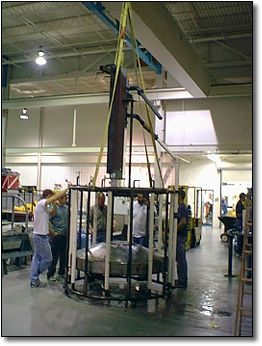forum
library
tutorial
contact

Wave Farm Planned to Harvest Ocean Energy
by StaffSolarAccess.com - December 29, 2003
|
the film forum library tutorial contact |

|
Wave Farm Planned to Harvest Ocean Energyby StaffSolarAccess.com - December 29, 2003 |
 Minneapolis, Minnesota -- Minnesota-based energy technology company Independent Natural Resources Inc. (INRI) has successfully tested its new system for transferring ocean-wave power into renewable energy. Conducted in a wave tank at Texas A&M University's Offshore Technology Research Center, INRI's tests validate the results of several years of concepts and planning, showing the company's "Seadog" wave-pump technology has the potential to serve as a viable source of renewable power by harvesting renewable power from ocean waves.
Minneapolis, Minnesota -- Minnesota-based energy technology company Independent Natural Resources Inc. (INRI) has successfully tested its new system for transferring ocean-wave power into renewable energy. Conducted in a wave tank at Texas A&M University's Offshore Technology Research Center, INRI's tests validate the results of several years of concepts and planning, showing the company's "Seadog" wave-pump technology has the potential to serve as a viable source of renewable power by harvesting renewable power from ocean waves.
To further prove the wave pump's viability, INRI is now looking to create a "wave farm" test field in a coastal area capable of providing consistent ocean swells -- a concept similar to electricity-generating "wind farms."
"Our tests at Texas A&M last month exceeded our expectations and we're confident that our engineers have developed a new proprietary technology that can serve as a safe, efficient system for gathering renewable energy from ocean waves," said INRI CEO Mark A. Thomas. "Going forward, we're seeking actual ocean environments where we can place a wave farm test field involving either 14 or 200 Seadog wave pumps. If the wave pump continues to perform as well as our tests have shown, we believe it has the potential to be a breakthrough for global energy production."
INRI's Seadog ocean-wave pump captures energy from ocean swells or waves to pump seawater to a land-based reservoir or water tower, where the water can be returned to the ocean through hydroelectric turbines, thereby producing inexpensive, renewable electricity. Tests on a scale Seadog prototype proved that a full-size version of the pump could consistently pump water 275 feet uphill at a pre-determined flow rate.
"Our technology avoids many of the problems other ocean-based power-generating technologies are struggling with today, because the Seadog doesn't involve any electrical components that can be damaged by sea water," said INRI Vice President Doug Sandberg. "And, because our device pumps water to a reservoir, it can store potential energy and generate power on demand, even when waves are too low to generate power. These two factors represent key advantages for our product."
According to INRI calculations, the company's wave-pump technology is potentially capable of generating 755 MW of hydroelectric energy for every one-square-mile pump field, assuming ocean swells averaging at least nine-feet. With swells of at least five-feet, a one-square mile pump field could generate approximately 242 MW.
"Coastal locations offering consistent wave heights of five-feet or greater aren't that uncommon," Thomas said. "For example, Point Reyes, off the coast of northern California, features more than 50-miles of coastline with wave heights regularly reaching five to 21 feet."
learn more on topics covered in the film
see the video
read the script
learn the songs
discussion forum
